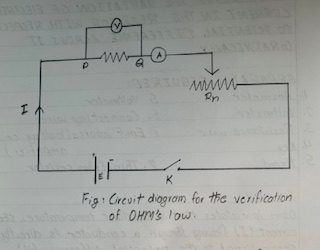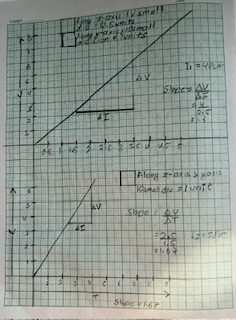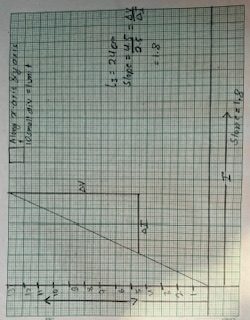APPARATUS REQUIRED:
1. Ammeter
2. Voltmeter
3. Resistance wire.
4. Key
5. Thread
S. Voltmeter
6. Connecting wires.
7. E.m.f source (battery or amplifier)
8. Thin film resistor.
THEORY:
Ohm law states that at constant temperature, the current (I) flowing through a conductor is directly proportional to the potential difference (V) applied across its ends. i.e.
I XV
Conversely,
VX I
or, V=IR
Where, ‘R’ is proportionality constant called the resistance of the conductor.
If we plot a graph between voltage(V) and current (I) .Straight line passing through origin is obtained. The slope of the straight line gives the value of resistance of the conductor.

For Resistivity
It has been found that the resistance of conductor is
1. Directly proportional to the length of the conductor i.e. RxL ——— (i)
2. Inversely proportional to cross sectional area of conductor
i.e. RX1/A—-(ii)
Combining equation (i) and (ii) we get.
R x l/A
or, R= p L/A ——–(iii)
Where, ‘P’ is the proportionality constant and called the resistivity of the material at the conductor and its value is constant for a single material at constant temperature.
Now A = πd² / 4 (for cylindrical wire)
Where d is the diameter of the wire
Then, equation (111) comes
R= pl /(πd² / 4)
or, R= 4pl / πd²
or P = R.πd² / 4L
In case of the film resistor
A=width x thickness
R= pl/A = pl/ b x t.

OBSERVATION TABLE
| No.of obs. | Length of wire | Ammeter reading (l) | Voltmeter reading Increasing mean volt R = V/I | Mean R | remarks |
| 1 | L1 = | 0.5 | 0.6 0.6 1.2 | ||
| 2 | 0.9 | 1.4 1.4 1.55 | 1.4725 | ||
| 3 | 1.4 | 2.2 2.2 1.57 | |||
| 1 | L₂ = | 1 | 1.4 1.4 1.4 | ||
| 2 | 1.5 | 2.1 2.1 1.4 | |||
| 3 | 1.9 | 3 3 1.57 | 1.505 | ||
| 1 | L3 | 1.1 | 1.6 1.6 1.45 | ||
| 2 | 2 | 3.3 3.3 1.65 | |||
| 3 | 2.5 | 4.5 4.5 1.8 | 1.665 |
Value of 10 smallest division: 1A (of ammeter)
Valve of 1 smallest division: 0.1A (of ammeter)
Value of 10 smallest division: 1V (of voltmeter)
Value of 1 smallest division: 0.1V (of voltmeter)

CONCLUSION
For each I-V graph, straight line passing through the origin is obtained. Hence, Ohm’s law is verified.
PRECAUTIONS
1. All the connection should be clean and tidy
2. The reading of balance points should be taken carefully.
3. The current shouldn’t be passed continuously for very long time

